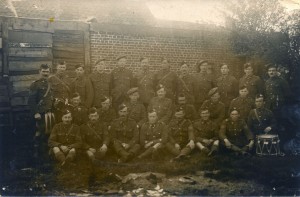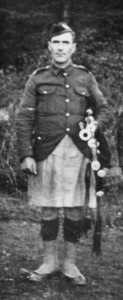Pipe Major James Groat D.C.M., M.M. and Bar

A group of 16th Battalion C.E.F. soldiers. Pipe Major James Groat DCM, MM and Bar (standing extreme left, back row).
THE NONCHALANT PIPER
The pipers of the 16th Battalion C.E.F. received several awards for gallantry during the Great War. These awards included the posthumous Victoria Cross to Piper James Cleland Richardson as well as seven other pipers being awarded the Military Medal. In addition, Pipe Major James Groat received the Distinguished Conduct Medal and the Military Medal and Bar representing three awards for gallantry in the face of the enemy. With the recent online publication of citations for several Great War Military Medals, awarded to the C.E.F., we have now learned the circumstances as to how Pipe Major Groat earned such considerable recognition.
Groat was born at Durris, Kincardine, Scotland December 18, 1884 and came to Canada in 1906. Prior to the war he was worked in Winnipeg as a Motorman with Winnipeg Electric. He joined the 16th Battalion of the Canadian Expeditionary Force September 23, 1914 at Valcartier, Quebec having arrived at Valcartier as a member of the 79th Cameron Highlanders of the Canadian Militia.
Citation for the award of the Military Medal
For most conspicuous gallantry and nonchalance under shell and machine gun fire in the attack of April 9th, 1917 on the THELUS trenches. His splendid example while piping the Commanding Officer to the new headquarters in the captured position, encouraged and had an immediate stiffening effect on the men when temporarily held up by enemy machine gun fire.
Citation for the award of a Bar to Military Medal
On Aug: 15th 1917, this N.C.O. according to Battn custom played the Headquarters forward to their new position through a terrific shell-fire. He remained in the captured position until the Battalion was relieved two days later. His example has built up the “esprit du corps” of the pipers of the Regiment to such an extent that there is always a keen rivalry amongst them to lean their companies into section. (sic – should read “action”.)

Piper James Groat DCM, MM and Bar.
Citation for the award of the Distinguished Conduct Medal
For conspicuous gallantry and devotion to duty on the 20th (sic – should read 2nd) September, 1918, in the second battle Arras. For the fourth or fifth time during this war he played his Battalion over the top in a battle. He was continually under heavy machine gun fire and at one time was playing in the midst of furious hand-to-hand fighting. At last he was wounded by shrapnel after adding a fine record to the courage of Highland Pipers.
During the Great War Pipe Major Groat was wounded at Arras, France September 2, 1918 when he received a shrapnel wound to his left arm that led to a compound, oblique fracture of the humerus. The wound was large and open when he was admitted to Lord Derby War Hospital, Warrington, England. The wound was severe, ragged, septic but slowly healed. For three months he wore a “Thomas” splint and felt pain through his 1st, 2nd and 3rd fingers as well as around the muscles of his thumb.
In June 1919 he was admitted to Manitoba Military Hospital in Winnipeg where it was further reported, “Muscles of arm and forearm and hand slightly wasted. Shoulder movements slightly limited. Elbow-flexion slightly limited…Wrist and all finger movements are defective especially on radial side of hand. Sensation-partial loss of tactile over whole hand but marked over radial distribution…Considerable pain present…Hand grip poor…Triceps very poor as large part of muscle has been shot away.” (Case History Sheet from Service Record)
Following surgery July 25, 1919 Groat continued on a course of treatment through to June 7, 1920 when he was discharged from hospital. Having served 43 months in France and Flanders he was discharged medically unfit July 6, 1920. No other details are known.
Pipe Major Groat died March 27, 1961 at Winnipeg, Manitoba where he lived at the Majestic Hotel. He was buried in the Military Section of Brookside Cemetery, Winnipeg.

Comments